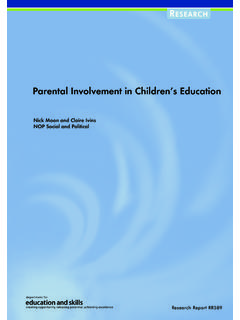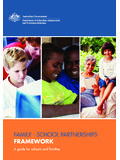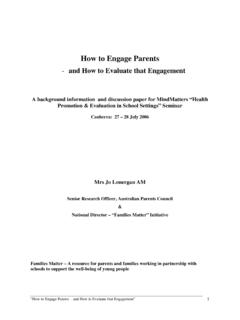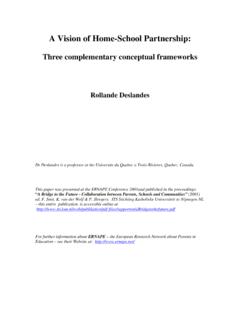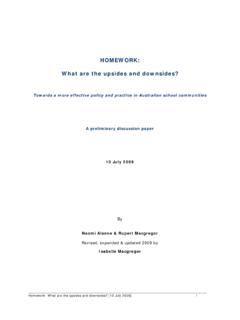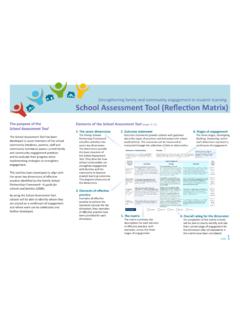Transcription of FRAMEWORK - familyschool
1 FAMILY - school PARTNERSHIPS FRAMEWORKA guide for schools and families1 Contents1. Introduction2. Vision3. Principles which underpin effective Family- school Partnerships4. Supporting Structures5. Key Dimensions of Family- school Partnerships6. Suggested Strategies for school Communities in Developing Partnerships7. Suggested Strategies for school Systems in Developing Partnerships 8. Glossary9. Appendices10. The Elements of Best Practice11. Case Studies24445814151619202 IntroductionWhat are family- school partnerships?Family- school partnerships are collaborative relationships and activities involving school staff, parents and other family members of students at a school . Effective partnerships are based on mutual trust and respect, and shared responsibility for the education of the children and young people at the are family- school partnerships important?Families are the first educators of their children and they continue to influence their children s learning and development during the school years and long afterwards.
2 Schools have an important responsibility in helping to nurture and teach future generations and families trust schools to provide educational foundations for their children s future. At the same time, schools need to recognise the primary role of the family in education . This is why it is important for families and schools to work together in partnership. Research demonstrates that effective schools have high levels of parental and community involvement. This involvement is strongly related to improved student learning, attendance and behaviour. Family involvement can have a major impact on student learning, regardless of the social or cultural background of the involvement in schools is therefore central to high quality education and is part of the core business of aim of the Family- school Partnerships FRAMEWORK is to encourage sustainable and effective partnerships between all members of the school community, including teachers, families, and students. These partnerships should: view each partner as making equally valuable contributions, while respecting different contributions; respect student needs and preferences; address barriers to involvement in schools by families, in particular Indigenous families, and actively help previously uninvolved families to become involved; create better programs, opportunities and learning for students; give families appropriate opportunities to contribute to school decision-making and governance; and contribute to professional satisfaction for principals and family- school partnerships may not always be easy.
3 It requires commitment and time. Because of pressures and circumstances, many families will need special arrangements, or extra support, to enable them to become actively involved in their children s school lives, and to help their children get the most from results of this effort will be significant. Families that understand the education system and the difficulties schools face are a valuable source of support which schools cannot afford to underestimate. Schools that engage families in their children s learning are tapping in to a rich source of information and expertise and can help build is this different from what every school does already?Schools vary considerably in their commitment to family- school partnerships and the energy and skills they apply to towards partnerships requires a significant change in attitudes by some schools and families in order to create relationships where they see one another as allies in does the FRAMEWORK contain?The FRAMEWORK contains: a vision for improved partnerships between Australian families and schools; a set of principles to guide families and schools in developing partnerships; seven key dimensions of effective family- school partnerships; a set of strategies providing practical guidance to school communities and school systems in implementing and fostering family- school FRAMEWORK is based on existing good practice and provides an agreed national approach to guide schools and families working on these FRAMEWORK recognises that many positive developments and innovations are already occurring in schools and that a one size fits all approach to partnerships is not feasible.
4 Partnerships need to be underpinned by broad principles and strategies but remain specific to school context, including family/community characteristics, school size, levels of schooling and student have a FRAMEWORK ?The FRAMEWORK is a resource for school communities. Its purpose is to encourage and guide schools, school systems, parent groups and families to support family- school partnerships. Who is it for?The FRAMEWORK is intended for school systems, schools, school leaders (both staff and parents), families and other interested people working together to develop partnerships. The FRAMEWORK is an opportunity to take stock and ask: to what extent are partnerships occurring?; in whose opinion are partnerships occurring?; and is there evidence from staff and parents on the performance of partnerships?Who prepared it?The FRAMEWORK has been prepared by the national parent bodies in Australia the Australian Council of State school Organisations (ACSSO), the Australian Parents Council (APC) the Australian Government, and other key stakeholders, including State and Territory government and non-government school authorities, and school principals VisionFamilies and schools work together as partners in the education of children and young people.
5 Principles which underpin effective Family- school Partnerships1. All families and schools want the best for their All children have the right to the opportunity to reach their full Families are the first and continuing educators of their Effective schools provide a nurturing and supportive learning Families and schools value quality teaching and respect teachers professional Families and schools value the diversity of families and use this as a resource for building partnerships and Family- school partnerships are based on mutual responsibility, respect and Leadership is critical to building, maintaining and renewing Family- school partnerships improve student motivation and Family- school partnerships strengthen the connections between schools and their communities. 11. Partnerships can involve all organisations that support families and schools. Supporting StructuresIn order to create the conditions that enable effective family- school partnerships to be developed and sustained, the following supporting structures need to be in place at both systemic and school levels:I.
6 Family- school action teams to plan, organise, implement and evaluate partnerships;II. school policies and procedures which explicitly state and clearly integrate the principles and practices of effective partnerships;III. support networks, to enable school communities to share ideas, issues and best practice; andIV. accountability to the community, to report on successes and drive improvement in communities are encouraged to review their current supporting structures, policies and procedures and develop new ones where necessary. This may include establishing a dedicated family- school action team of school leaders, teachers and parents (appointed by the parent body) or using an existing working group that includes parents to develop and coordinate partnership plans and activities. Any successful partnership will involve parents, carers and families in preparation, planning, implementation and review. A dedicated family- school action team of teachers, school leaders and parents to develop and coordinate partnership plans and activities can provide the basis for improving partnerships more family- school action team would: audit existing arrangements and practices and collect information on the views, experiences and wishes of teachers, parents, school leaders and students; confirm that the school leaders and the parent network endorse the concept of partnership and inform the school community; develop plans for implementation, setting goals, timelines and success indicators against the Key Dimensions of the Family- school Partnerships FRAMEWORK ; arrange training for action team members; implement agreed activities; evaluate the effectiveness of the partnership activities; continue to improve and coordinate practices against the Key Dimensions of the Family- school Partnerships FRAMEWORK ; and explore options for new partnerships.
7 Key Dimensions of Family- school PartnershipsThe Family- school Partnerships FRAMEWORK identifies seven dimensions as guidelines for planning partnership activities. These seven dimensions are:A. communicating;B. connecting learning at home and at school ;C. building community and identity;D. recognising the role of the family;E. consultative decision-making;F. collaborating beyond the school ; andG. brief description of each dimension is provided CommunicatingThis key dimension emphasises that effective communication: is active, personal, frequent and culturally appropriate; is where schools go out of their way to make families feel welcome and valued; is a two-way exchange between families and schools; involves not only an exchange of information, but also an opportunity for schools and families to learn about each other; makes clear that families are genuine partners and can help solve big problems; builds bridges across cultural and language divides including actively seeking access to these families; needs to take into account cultural and linguistic diversity and not assume that all families communicate in the same way; is open to families needs and attitudes; acknowledges and celebrates the families input.
8 Is multi-dimensional it may: be formal or informal, happen in different places (both in the school and in other sites such as community centres), and use different methods (oral, written, face-to-face, phone, email, etc).6 Family- school communication needs to be taken seriously and must be valued, recognised, and rewarded by schools and education systems. It is essential to provide teachers and school leaders with education and training programs to prepare them to communicate effectively with families in an approachable manner. It is equally important to empower and encourage families to communicate effectively with Connecting Learning at Home and at school This key dimension emphasises: understanding by families and schools of the overlap between the home and school environments; the connection between successful partnerships and the child s learning, including the importance of high expectations from both teachers and parents to the child s success at school ; families and schools working together to create positive attitudes to learning in each child; ensuring families are informed about and understand their child s progress; families and schools valuing and using the skills and knowledge children bring both from the home to the school and from the school to the home; families and schools recognising and using learning opportunities in the home environment; parents working with teachers in the educational decision-making process for their individual child.
9 And schools becoming a venue and agent for parental self-growth, learning and the development of new Building Community and IdentityThis key dimension emphasises activities that improve the quality of life in a community while honouring the culture, traditions, values and relationships in that community. By including activities that shape students sense of identity and culture, schools can build a sense of community in each student. The work of schools includes aspects of the social, emotional, moral and spiritual development of young people. Thus schools have a role to play in promoting both personal growth and cultural renewal. Schools can act as a focal point for communities to come together and engage in capacity-building. D. Recognising the Role of the FamilyThis key dimension emphasises that as primary educators of their children, parents and families have a lasting influence on their children s attitudes and achievements at school . They can encourage their children s learning in and out of school and are also in a position to support school goals, directions and ethos.
10 Parents look to schools to provide secure and caring environments for their and schools can reach mutual understanding of each other s roles and priorities in partnerships by: exploring the nature of parent and family s role in the education of children to develop mutual understanding; offering strategies for family support and encouragement of children s learning at school ; organising workshops/discussions/meetings and demonstrations around areas such as literacy and numeracy, home and classroom work, raising resilience and confidence in young people, transitions and careers and so on, depending on local needs and priorities; ensuring families understand school goals, curriculum and the social objectives of schooling; ensuring schools understand family, parent and community priorities; ensuring schools are sensitive to parents sensibilities; ensuring schools are realistic, patient and brave; establishing an environment where schools show leadership which is visible and available; helping schools become a place that parents can call their own including creating real roles for parents who come into the school ; building relationships; and developing skills, such as communication, collaboration and conflict Consultative Decision-MakingThis key dimension emphasises that parents are entitled to be consulted and participate in decisions concerning their own can play meaningful roles in the school decision-making processes.
